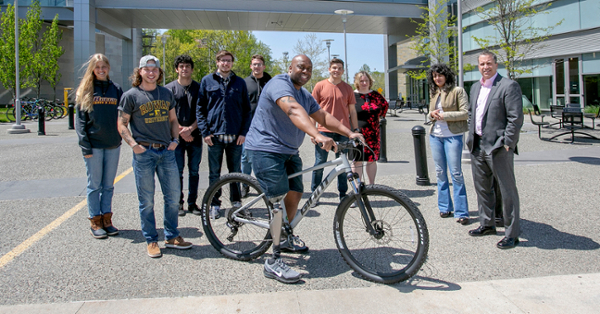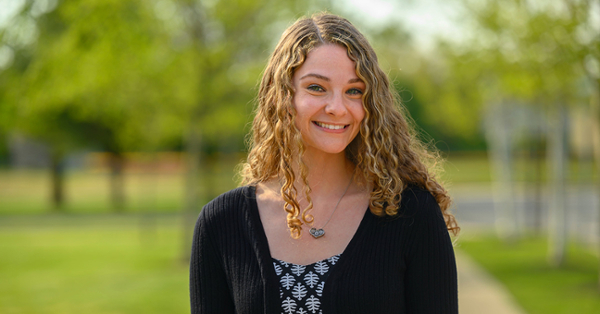Student Spotlight
Student Spotlight
Rowan engineering students help veteran amputee return to cycling

5/19/22 - For the first time since losing his right leg during a 2004 mission in Iraq, Army veteran Hilbert Caesar can ride a mountain bike outside, due to the work of six students led by the Department of Biomedical Engineering at the Henry M. Rowan College of Engineering and Quality of Life Plus, a national nonprofit serving injured veterans, first responders and others in service to the nation.
The organization matches STEM students in universities around the country with “challengers” like Caesar to create innovative technology solutions to improve their quality of life. Through physical rehab and assistance from the U.S. Department of Veterans Affairs, the York, Pennsylvania, resident can walk, drive and even pedal a stationary bike with his prosthetic leg. But he wanted to get outside and ride a bike with his family. More >>

Engineering for good: She’s already on the job to make the world better
Since she was 14, Lauren Repmann has worked at an accelerated pace. By the time she graduated high school, she already had her associate’s degree. Now, at 21, she has a full-time position at Merck in Durham, North Carolina. She is the first student from Rowan University to land a spot in the pharmaceutical company’s three-year Manufacturing Leadership Development Program (MLDP)—and since she graduated with a biomedical engineering degree in December, a full semester early, she’s also the first in her cohort to start in the program.

BME major Gatha Adhikari works at the cellular level
4/28/21 - In April 2015, as Gatha Adhikari studied for her final high school exams in Kathmandu, Nepal, a 7.8 magnitude earthquake struck near the city, crumbling buildings and tipping off landslides in the nearby Himalayas.
Hours away from her own family in Begnas Tal, Adhikari helped rescue trapped people, some missing limbs. Nearly 9,000 died and more than 22,000 were injured in the strongest earthquake to hit Nepal in 81 years.
“It was so bad … to see it right in front of your eyes and not to be able to do anything,” Adhikari said. The experience shaped her career goals.
Already determined to pursue higher education in the United States, Adhikari decided to study biomedical engineering at the Henry M. Rowan College of Engineering, a 20-hour flight from everything familiar, but just a text away from her worried mom.
“If I want to do something, I just go for it,” Adhikari said. The summer before arriving at Rowan, Adhikari volunteered to teach children in a remote village, a journey that required two short flights and a four-day walk alone. She took a paper map and left, later calling it one of the “best decisions I ever made.”
As a Rowan first year student, Adhikari commuted two hours each way by bus. The first from her tight-knit community to study in the United States, she had no friends or family to guide her. She found jobs around campus, volunteered to work in an engineering lab and became a resident assistant, building connections through her learning communities and reaching out to help isolated students like herself.
In the labs of Dr. Mary Staehle, Dr. Yusuf Mehta and Dr. Sebastián Vega, Adhikari explored wide-ranging fields of research: from neurodevelopmental toxicology in flatworms to analyzing stem cells and their complex interactions with materials.
When the pandemic disrupted her summer research opportunity at Penn Medicine, Adhikari shifted gears to a different discipline and immersed herself in Rowan’s Center for Research and Education in Advanced Transportation Engineering Systems (CREATES), studying the correlation between traffic congestion, hospital air quality and patients’ health.
“She’s one of those students who has the ability to pick up something and excel,” said Mehta, director of CREATES. “She didn’t hesitate or say, ‘This is not my area.’ That didn’t bother her at all … nothing stopped her.”
During her final year at Rowan, Adhikari worked alongside graduate student Sarah Furman in Vega’s lab to develop a technique that forces stem cells into different shapes on materials of varying stiffness. Understanding how stem cells communicate with materials outside of the body could one day be used to develop new techniques to control stem cell differentiation—or what stem cells become when they mature.
The stem cells used in the project measure just 50 micrometers across or fifty-millionths of a meter, about the width of a strand of human hair. Making patterns and then forcing stem cells to take to those shapes took more than a year of work. As a result, Adhikari and her research partner will have their names alongside Vega’s on a peer-reviewed research paper, another contribution toward understanding the behavior of stem cells.
“You have to be passionate for research, no matter how obscure it could be,” Vega said, as he looked at the resulting images of glowing cells on his screen. “I’m very proud of them. They worked diligently and discovered something new.”
After graduation, Adhikari will pursue a doctorate degree in biomedical engineering at the University of Maryland. The 22-year-old is not yet sure which research area she’ll settle on: tissue engineering, regenerative medicine, wound healing or perhaps advanced biomaterials. Wherever in the world she ends up, Adhikari hopes to make her community better by innovating to provide accessible and equitable solutions to pressing medical needs.
“I want to further study biomedical engineering to pay it forward,” Adhikari wrote in her graduate school application. “I know firsthand what it is like to lose your loved ones due to a lack of access to adequate health care.”